- Overview
- Trip Outline
- Trip Includes
- Trip Excludes
- Gallery
- Reviews
- FAQ
As a safari aficionado, you should make it a point to witness the Great Wildebeest Migration in Africa at least once in your lifetime.
The big migration in Africa is one of the most stunning safari occurrences, taking place in Kenya and Tanzania in East Africa.
It is an annual migration of millions of wildebeest, zebras, antelopes, and other hoofed animals from Tanzania's award-winning Serengeti National Park. Their survival instinct drives them to Kenya's most spectacular region, the Masai Mara Reserve.
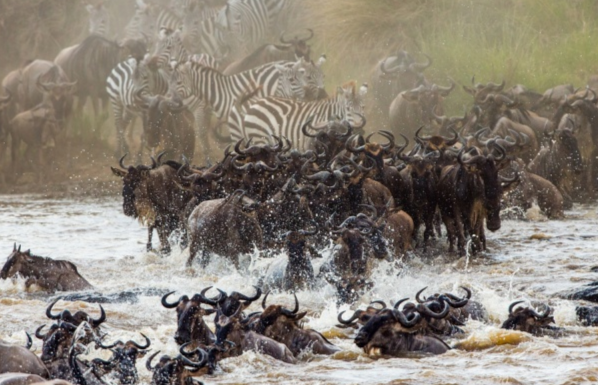
The vast wildebeest migration lasts a year. Between January and March, the animals congregate at Tanzania's Ngorongoro Conservation Area. The grass and water are plentiful here, making it ideal for the birthing season. During Tanzania's big migration, it is believed that over 40,000 calves are born in three weeks. Around April, the big migration animals begin to travel towards the Central Serengeti, and as the days transition to weeks, they gradually proceed to the western corridor.
They are discovered in June near the banks of the Grumeti River, whence they proceed north towards the Mara River. They will reach the banks of the Mara River in July and undertake the spectacular crossing that constitutes Kenya's big migration.
On the Kenyan side, you may see this show between July and October. More information on this event may be found on the Great Migration Africa Wikipedia page.
The African wildebeest migration is a must-see safari phenomenon, but only if you visit a reputable safari organization. The itinerary is equally important since it specifies what you will do when you will do it, and how you will accomplish it.
Goldstep Safaris (www.goldstep.africa) takes pleasure in 'walking the walk' when it comes to organizing your wildebeest migration safari in Africa. We provide custom-made packages based on your budget, so you don't have to be concerned about Masai Mara safari expenses.
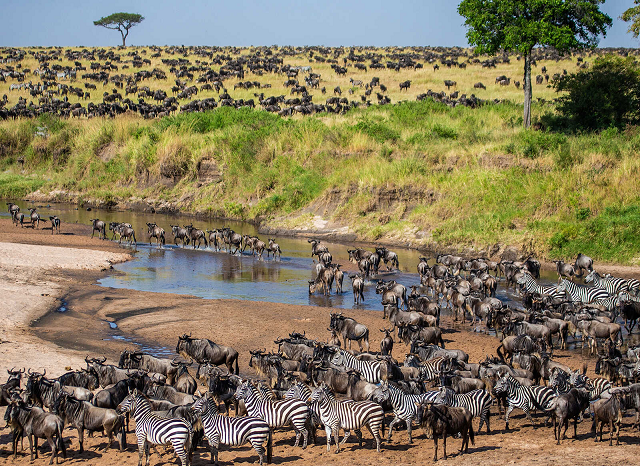
The Masai Mara has something for everyone, from budget to luxury guests. If you are planning a wildebeest migration safari in Kenya, here is one of our sample itineraries to serve as a reference. Remember that we can tailor your safari to your exact specifications.

Contact Golddstep Sfaris ( www.goldstep.africa) to Personalize Your Great Wildebeest Migration Experience in Africa.
Book the wildebeest migration safari package in this article or personalize your trip by calling +254 -115-655-877 or sending a WhatsApp message.
We may also be reached by email at safarioffers@goldstep.africa and miriam@goldstep.africa.
A comprehensive four-day itinerary for the Great Migration safari.
This itinerary takes you on a typical four-day safari to see the African wildebeest migration. This itinerary is predicated on a road safari, but we can also arrive at the Masai Mara by air or road.
Day 1: Arrive in Kenya, Transfer to Masai Mara, and Evening Game Drive
As is usual with our road trips to Masai Mara, we will meet you at the airport by 6:00 am. Although it might seem early, getting to the Masai Mara takes a few hours, and we prefer to stick to the schedule.
You will be taking a 4x4 safari land cruiser today. With the roof open, it handles the road better and offers excellent game viewing.
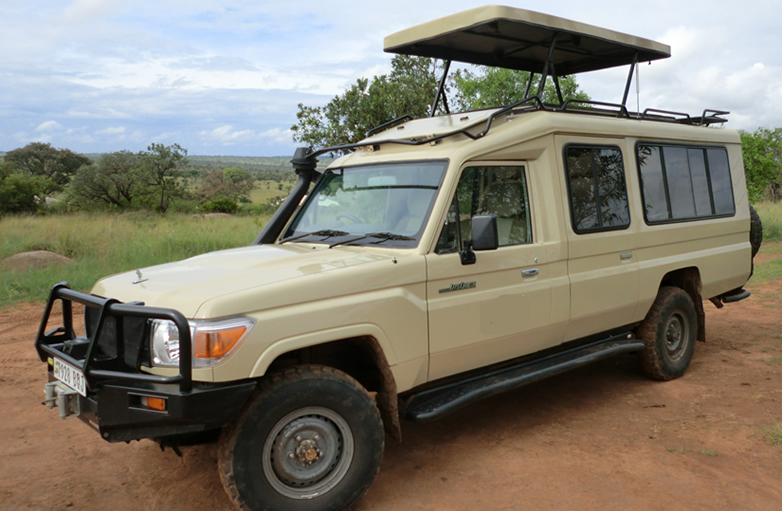
The safari guide will leave Nairobi city after being picked up and travel the Southern Bypass before merging onto the Nairobi-Nakuru highway.
This early in the day, the air is crisp and cool, with hopes of sunlight later. The vista of the Great Rift Valley should be your first stop.
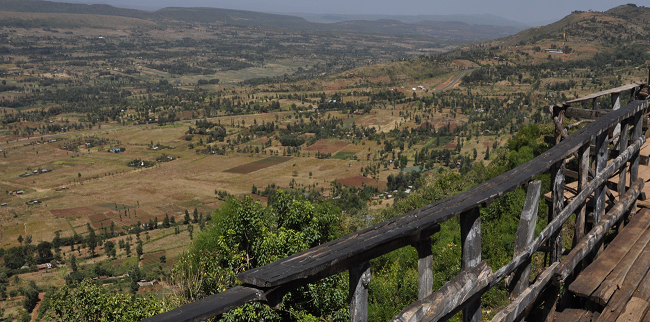
The Great Rift Valley spans 7000 kilometers across the Middle East and Africa.
From this perspective, this vast topographic valley stretches as far as the eye can travel.
This is a great view for your first safari shots.

The location has a ton of curio shops, so now is the ideal time for you to start filling up on mementos.
You return to the road after spending some time on the lookout. Enjoy the sights of the Kenyan scenery while your guide drives you to Narok Town, your next destination.
For individuals who are not accustomed to rising early, this is also an excellent time for a night of sleep. When you get to Narok Town, you should stretch your legs, use the restroom, and go shopping for any last-minute necessities.
Recall that the following three days will be spent in the wilderness. After that, the guide will transport you to Masai Mara.
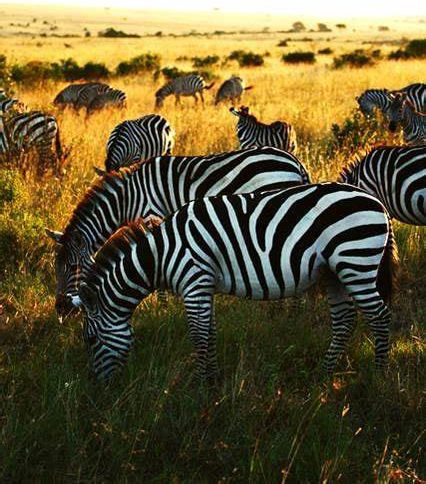
You will be in the center of Masai Mara and close to the eighth wonder of the world in around two hours. If you want to stay within the park, the guide will pay your park fees and obtain your official ticket.
If you notice animals as soon as you step through the gate, don't freak out! After giving you a refreshing fruit drink upon arrival, the lodge/camp personnel will lead you to your accommodation.
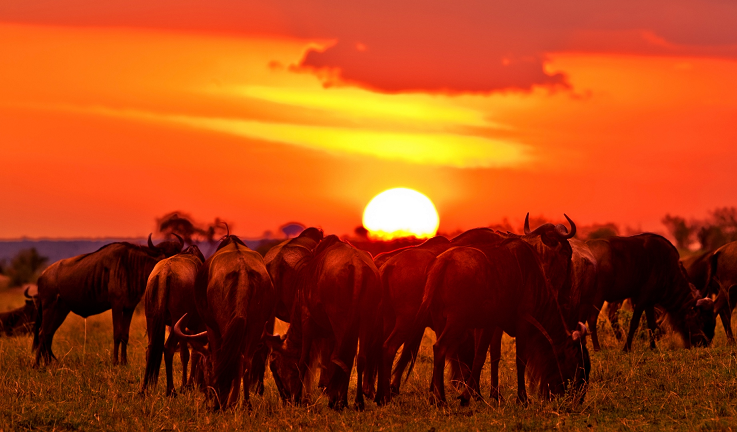
The guide will now leave you to unwind since it has been a hard day. After that, you will go on a nighttime game drive that lasts from 3 p.m. to around 6 a.m.
Day 2: Full-Day Game Drive at Masai Mara National Reserve – Experience the Migration
You get up early on your second day at the Masai Mara. You are going to embark on a full-day game drive today, and you should bring lunch. You will thus only return to the lodge in the evening.
The portable cooler is stocked with water and other soft beverages, so don't worry about the heat. Straight after a substantial breakfast, you're leaving. The Mara River, where all the action takes place, is your first destination.
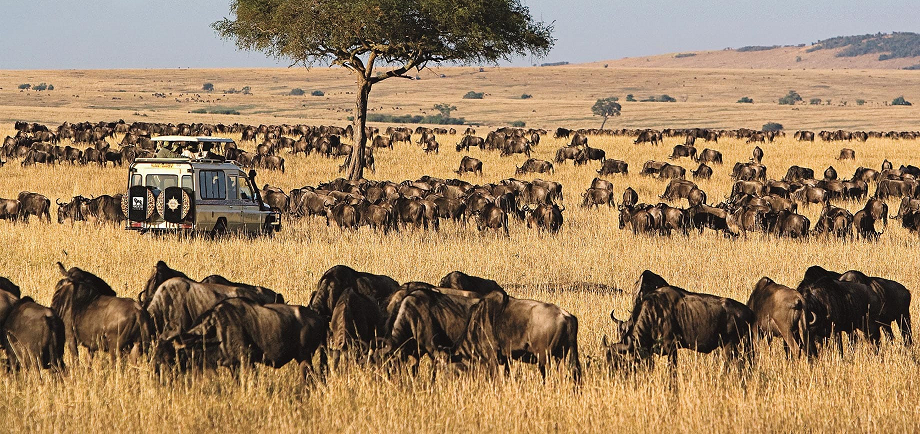
You will witness several herds going about their daily lives while the guide drives you there.
Now and then something fascinating happens that makes you want to pause. For example, in 2021, we saw a giraffe giving birth while on the wildebeest migration.
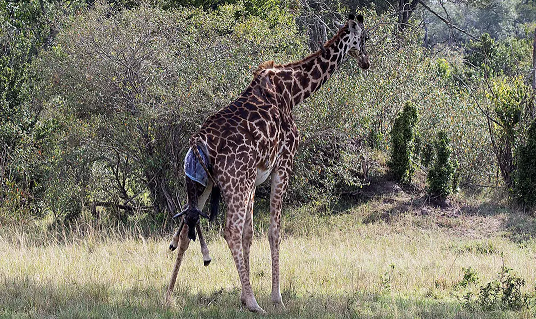
This was a worthwhile detour. When you get to the Mara River, some safari cars have already pulled in and are positioned for maximum impact. After joining them, the guide quickly becomes engrossed in the events below.
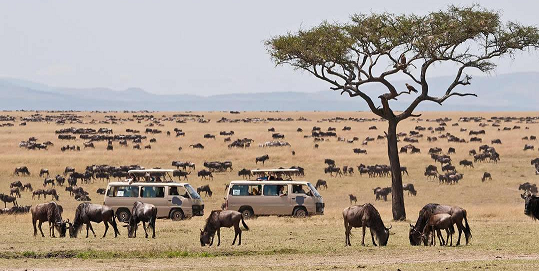
Many thousands of wildebeests have gathered along the Mara River, attempting to cross, as is customary with the African wildlife migration. Big crocodiles are waiting for the unwary in the deep waters below, and they won't let them pass.
This is just the beginning; as they avoid the ravenous crocodiles, they come across lions, cheetahs, and hyenas.
It turns becomes a game of survival of the fittest once more. The beautiful green grass on the other side will only be enjoyed by the strongest, bravest, and most determined.
You will undoubtedly shoot pictures and movies that you will always cherish. After seeing the activity all morning, you travel to a picnic place with shade as the sun rises.
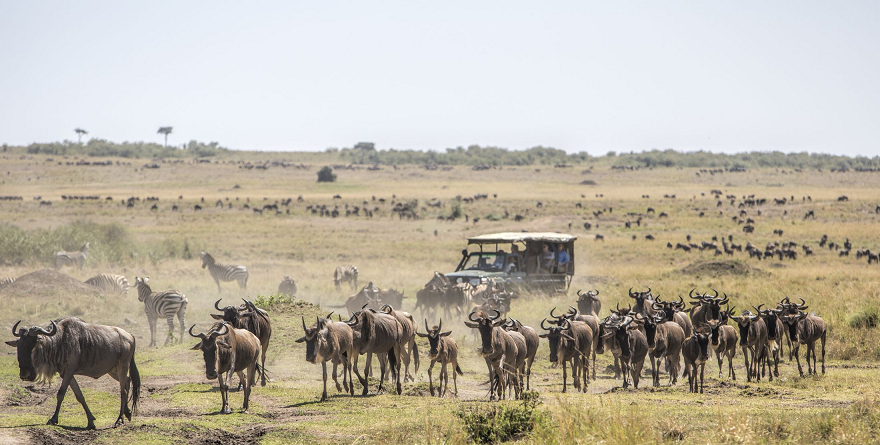
The enormous exodus never becomes boring and is always thrilling. Following a filling midday meal, you return to a new location along the river.
In the same way that the water is deeper in some places, the banks are steeper in others. When trying to cross during the wildebeest migration from the Serengeti, this creates various dynamics for the animals.
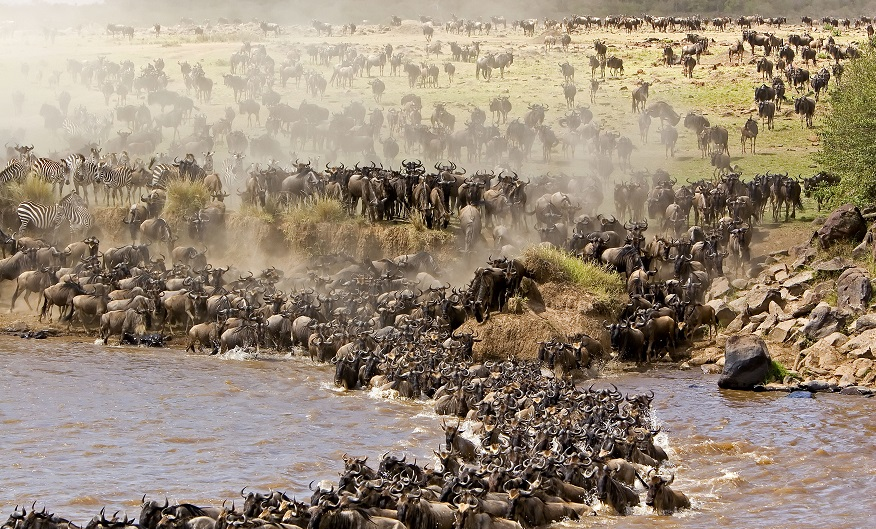
The difficulty of crossing the seas increases with their depth. It is more difficult to spot the predators that are concealed underneath. You take in the show for the remainder of the afternoon and, as 4 p.m. approaches, you gently make your way back to the hotel by car.
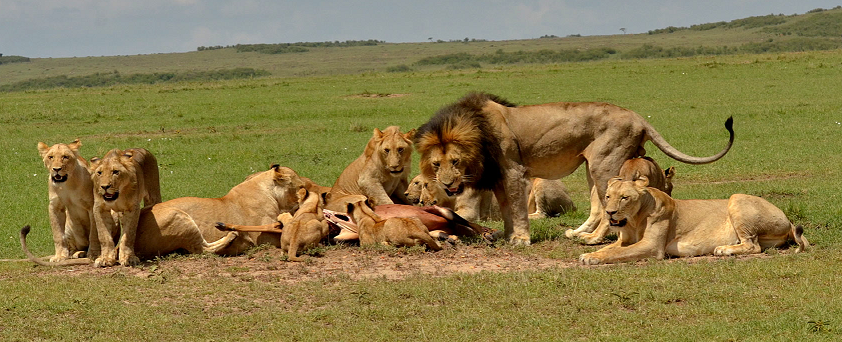
The game drive never ends at the Masai Mara because there's always more to view on the way back. Before supper, our tour will drop you off to unwind in your room, in the bar, or by the pool.
Day 3: Optional Hot Air Baloon Safari & Full-Day Game Drive at Masai Mara National Reserve
You have the option to spend the second day at Masai Mara National Reserve having a full-day game drive, just like the first. An alternative is to go on a hot air balloon safari throughout the day and then continue your wildlife drive into the evening.
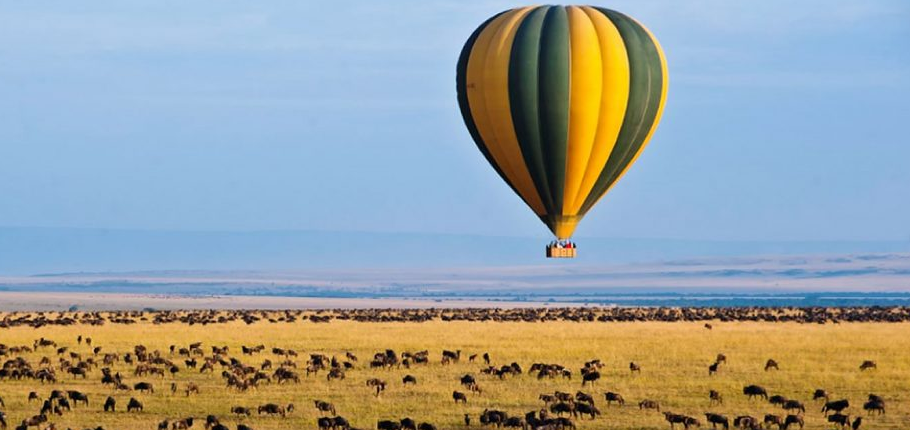
If you choose to go on a hot air balloon trip, the balloon business will come to your hotel or lodge early enough so that you may be at the launch location by 5:30 am.
Here, while the staff gets the balloon ready, you may enjoy some coffee. The pilot will also give you a safety briefing.
Once everything is set up, you're about to have one of the most thrilling sensations ever. You will be helped by the team to get into the basket. After that, the balloon will softly ascend, following the wind's whims alone.
There are two ways to view the Masai Mara: from the ground and from above. As you ascend, the wide savannah will unfold before your eyes, exposing all of its mysteries. The creatures, including zebras, elephants, lions, cheetahs, and wildebeest, will be simple to recognize.
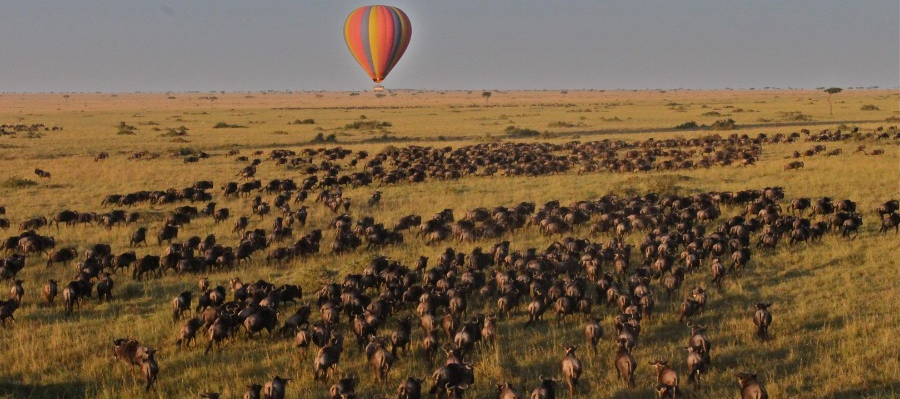
The park's meandering Mara River, isolated acacia trees, and verdant grass below will all be visible to you. Remember to snap lots and plenty of pictures! It will end after approximately an hour on the balloon flight, but things are going to get better soon.
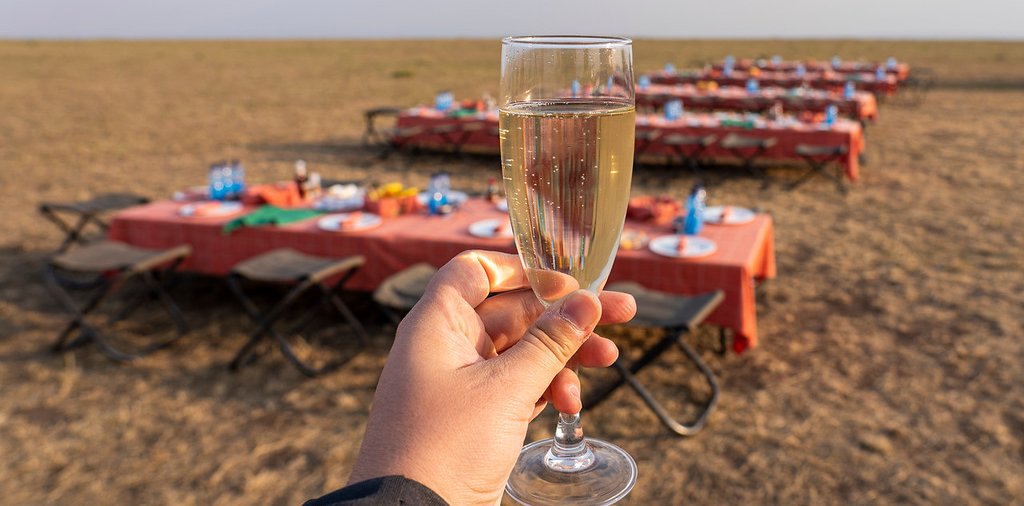
A delicious champagne brunch awaits you wherever you land. You could use this opportunity to review your images or buy high-quality ones taken by the staff.
Following breakfast, our safari guide will collect you and take you on a full day of wildlife drives in Masai Mara.
Day 4: Morning Game Drive, Visit a Maasai Village, and Transfer to Nairobi
You have one more day left at the Masai Mara. You will check out after breakfast at the resort, as is common with day visits. Before you head back to Nairobi, you have one final game drive.
There will be a break in a Maasai village with the safari guide. The Maasais are a modern-day Kenyan tribe with a rich cultural heritage.
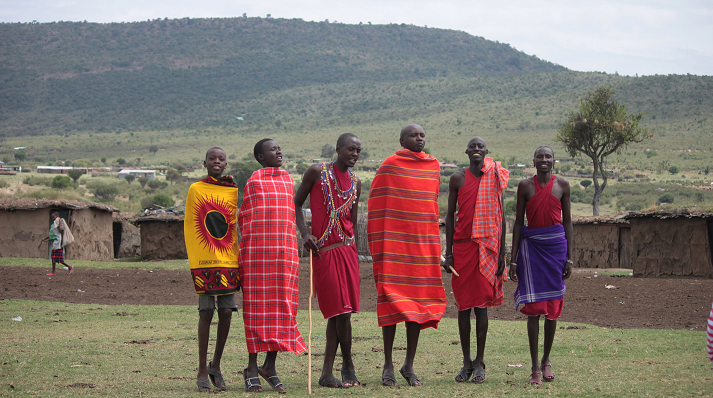
In addition to being the guardians of the Masai Mara, the Masai take pleasure in introducing guests to their culture. While the men take care of the animals, the ladies construct lovely traditional homes out of dirt and cow dung.
The majority of the young guys perform song and dance performances, dressing up. They work at the Masai Mara. You may purchase some traditional beaded decorations for your family back home or learn how to make your own.
Following an engaging and informative encounter, the safari guide will transport you to Nairobi. The guide will transport you to the Jomo Kenyatta International Airport or a hotel according to your itinerary.
Itineraries
Day 1
Arrive in Kenya, Transfer to Masai Mara, & Evening Game Drive
As is usual with our road trips to Masai Mara, we will meet you at the airport by 6:00 am. Although it might seem early, getting to the Masai Mara takes a few hours, and we prefer to stick to the schedule.
You will be taking a 4x4 safari land cruiser today. With the roof open, it handles the road better and offers excellent game viewing.
The safari guide will leave Nairobi city after being picked up and travel the Southern Bypass before merging onto the Nairobi-Nakuru highway.
This early in the day, the air is crisp and cool, with hopes of sunlight later. The vista of the Great Rift Valley should be your first stop.
The Great Rift Valley spans 7000 kilometers across the Middle East and Africa.
From this perspective, this vast topographic valley stretches as far as the eye can travel.
This is a great view for your first safari shots.
The location has a ton of curio shops, so now is the ideal time for you to start filling up on mementos.
You return to the road after spending some time on the lookout. Enjoy the sights of the Kenyan scenery while your guide drives you to Narok Town, your next destination.
For individuals who are not accustomed to rising early, this is also an excellent time for a night of sleep. When you get to Narok Town, you should stretch your legs, use the restroom, and go shopping for any last-minute necessities.
Recall that the following three days will be spent in the wilderness. After that, the guide will transport you to Masai Mara.
You will be in the center of Masai Mara and close to the eighth wonder of the world in around two hours. If you want to stay within the park, the guide will pay your park fees and obtain your official ticket.
If you notice animals as soon as you step through the gate, don't freak out! After giving you a refreshing fruit drink upon arrival, the lodge/camp personnel will lead you to your accommodation.
The guide will now leave you to unwind since it has been a hard day. After that, you will go on a nighttime game drive that lasts from 3 p.m. to around 6 a.m.
Day 2
Full-Day Game Drive at Masai Mara National Reserve – Experience the Migration
You get up early on your second day at the Masai Mara. You are going to embark on a full-day game drive today, and you should bring lunch. You will thus only return to the lodge in the evening.
The portable cooler is stocked with water and other soft beverages, so don't worry about the heat. Straight after a substantial breakfast, you're leaving. The Mara River, where all the action takes place, is your first destination.
You will witness several herds going about their daily lives while the guide drives you there.
Now and then something fascinating happens that makes you want to pause. For example, in 2021, we saw a giraffe giving birth while on the wildebeest migration.
This was a worthwhile detour. When you get to the Mara River, some safari cars have already pulled in and are positioned for maximum impact. After joining them, the guide quickly becomes engrossed in the events below.
Many thousands of wildebeests have gathered along the Mara River, attempting to cross, as is customary with the African wildlife migration. Big crocodiles are waiting for the unwary in the deep waters below, and they won't let them pass.
This is just the beginning; as they avoid the ravenous crocodiles, they come across lions, cheetahs, and hyenas.
It turns becomes a game of survival of the fittest once more. The beautiful green grass on the other side will only be enjoyed by the strongest, bravest, and most determined.
You will undoubtedly shoot pictures and movies that you will always cherish. After seeing the activity all morning, you travel to a picnic place with shade as the sun rises.
The enormous exodus never becomes boring and is always thrilling. Following a filling midday meal, you return to a new location along the river.
In the same way that the water is deeper in some places, the banks are steeper in others. When trying to cross during the wildebeest migration from the Serengeti, this creates various dynamics for the animals.
The difficulty of crossing the seas increases with their depth. It is more difficult to spot the predators that are concealed underneath. You take in the show for the remainder of the afternoon and, as 4 p.m. approaches, you gently make your way back to the hotel by car.
The game drive never ends at the Masai Mara because there's always more to view on the way back. Before supper, our tour will drop you off to unwind in your room, in the bar, or by the pool.
Day 3
Optional Hot Air Baloon Safari & Full-Day Game Drive at Masai Mara National Reserve
You have the option to spend the second day at Masai Mara National Reserve having a full-day game drive, just like the first. An alternative is to go on a hot air balloon safari throughout the day and then continue your wildlife drive into the evening.
If you choose to go on a hot air balloon trip, the balloon business will come to your hotel or lodge early enough so that you may be at the launch location by 5:30 am.
Here, while the staff gets the balloon ready, you may enjoy some coffee. The pilot will also give you a safety briefing.
Once everything is set up, you're about to have one of the most thrilling sensations ever. You will be helped by the team to get into the basket. After that, the balloon will softly ascend, following the wind's whims alone.
There are two ways to view the Masai Mara: from the ground and from above. As you ascend, the wide savannah will unfold before your eyes, exposing all of its mysteries. The creatures, including zebras, elephants, lions, cheetahs, and wildebeest, will be simple to recognize.
The park's meandering Mara River, isolated acacia trees, and verdant grass below will all be visible to you. Remember to snap lots and plenty of pictures! It will end after approximately an hour on the balloon flight, but things are going to get better soon.
A delicious champagne brunch awaits you wherever you land. You could use this opportunity to review your images or buy high-quality ones taken by the staff.
Following breakfast, our safari guide will collect you and take you on a full day of wildlife drives in Masai Mara.
Day 4
Morning Game Drive, Visit a Maasai Village, and Transfer to Nairobi
You have one more day left at the Masai Mara. You will check out after breakfast at the resort, as is common with day visits. Before you head back to Nairobi, you have one final game drive.
There will be a break in a Maasai village with the safari guide. The Maasais are a modern-day Kenyan tribe with a rich cultural heritage.
In addition to being the guardians of the Masai Mara, the Masai take pleasure in introducing guests to their culture. While the men take care of the animals, the ladies construct lovely traditional homes out of dirt and cow dung.
The majority of the young guys perform song and dance performances, dressing up. They work at the Masai Mara. You may purchase some traditional beaded decorations for your family back home or learn how to make your own.
Following an engaging and informative encounter, the safari guide will transport you to Nairobi. The guide will transport you to the Jomo Kenyatta International Airport or a hotel according to your itinerary.
- Pick up from JKIA on day 1
- Services of a professional safari guide
- Bottled mineral drinking water during the safari
- Exclusive use of a 4×4 safari land cruiser
- All park fees and government taxes.
-
Full-board accommodation at Masai Mara for three nights on a sharing basis
-
Game drives at Masai Mara on day 1
-
Full-day game drive at Masai Mara on day 2
-
Full-day game drive at Masai Mara on day 3
-
Game drives at Masai Mara on day 4 when staying inside the reserve
- Visit a Maasai village on day 4
- Transfer to Nairobi (JKIA) on day 4
- A hot air balloon safari – USD 475 Per Person
- Tips and gratuities to safari guide
- Local and internal flights
- Laundry services
- Visas
- Money transfer fee
The great wildebeest migration occurs in two East African countries, Kenya and Tanzania. The migrating animals move from Tanzania’s Serengeti Game Reserve to Kenya’s Masai Mara Game Reserve in a circular motion as they share the same ecosystem.
You can see the migration at different times of the year in Tanzania, depending on where the animals are assembled. For instance, the animals congregate at the Ngorongoro Conservancy area between January to March.
They move to central Serengeti and then towards the Grumeti River from March to April. By July, they are prepared to cross into Kenya, and the best time to see them at the Masai Mara is between July and October, after which they move back to the Serengeti.
Although the great wildebeest migration takes place in Kenya between July and October, you can visit the country for a safari all year. However, it is important to note these times are not fixed, and nobody knows what drives the animals to migrate.
Scientists believe that they follow the scent of the rain (hence green grass), but there could be other explanations. For the most part, they seem to arrive in Kenya mid-to-end of July. Towards the end of October, they start moving back to the Serengeti, and the cycle starts all over again.
This is a common question that we get from our guests. As mentioned earlier, both the Serengeti and Masai Mara game reserves share the same ecosystem. They are very much alike, save for size, as the Serengeti is much more expensive than the Masai Mara.
The wildebeest migration in Africa is quite different in both places, and our first answer is always to visit both if you can! We understand, however, that this may not always be possible. These countries also boast some of the best beaches globally, Zanzibar and Diani Beach.
The cost of your African wildebeest migration will depend on several factors. There is the cost of flights to and from your country and personal effects. The cost will also vary depending on the kind of accommodation you choose, the safari duration, and the type of transportation you use.
For instance, if you stay at a five-star tented camp, the cost will be higher than if you stay at a three-star lodge. Similarly, flying costs more than driving, and the longer you stay, the more expensive the trip will be.
The beauty of a Masai Mara migration safari in Kenya is that you can have a great time on any budget. Here is a rough guide of how much the trip costs, but this can change depending on your preferences:
• A budget Kenya great wildebeest migration Safari package will be provided on booking.
. The cost of your African wildebeest migration will depend on several factors.
- There is the cost of flights to and
from your country and personal
effects.
- The cost will also vary depending
on the kind of accommodation
you choose, the safari duration,
and the type of transportation
you use.
For instance, if you stay at a five-star tented camp, the cost will be higher than if you stay at a three-star lodge. Similarly, flying costs more than driving, and the longer you stay, the more expensive the trip will be.
The beauty of a Masai Mara migration safari in Kenya is that you can have a great time on any budget. Goldstep Safaris will provide a rough guide of how much the trip costs, but this can change depending on your preferences:
• A budget Kenya great wildebeest migration Safari package costs anything from $300 per person sharing per day.
• A mid-luxury Kenya great wildebeest migration safari package costs as little as $450 per person sharing per day.
• An all-inclusive luxury Kenya great wildebeest migration safari package costs anything from $700 per person per day.
The great migration in Africa constitutes the peak safari season in Kenya. This is the most sought-after time for a safari, and as you can imagine, there will be high demand for lodges/camps and transportation.
For this reason, we recommend that you start planning your safari well in advance, even as early as a year. There might also be lots of back and forth with your travel agent regarding various aspects of the safari.
Safari lodges, for instance, fill up quickly between July and October, and booking early enough will guarantee accommodation for you and your family. You will also be able to choose the accommodation of your choice, rather than being forced to choose between a few last-minute choices.
Similarly, flights may fill up if you need to fly between different places, but booking in advance might see you qualify for good discounts. We all know how expensive last-minute flights can be.
When you start planning your safari early, you will have ample time to get your documents in order, renew passports, get necessary vaccinations, etc. You will also be able to do enough research on the country and places you will be visiting, which can significantly enrich your experience.






There are no reviews yet.